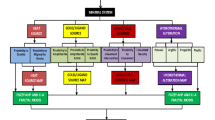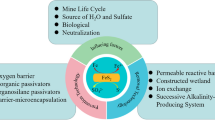Abstract
Geological contacts in lateritic metal deposits (footwall topographies) often delineate the orebody boundaries. Spatial variations seen in such contacts are frequently higher than those for the metal grades of the deposit. Therefore, borehole spacing chosen based on the grade variations cannot adequately capture the geological contact variability. Consequently, models created using such boreholes cause high volumetric uncertainties in the actual and targeted ore extraction volumes, which, in turn, lead to high unplanned dilution and ore losses. In this paper, a method to design optimum ore/mining boundaries for lateritic metal deposits is presented. The proposed approach minimizes the dilution/ore losses and comprises two main steps. First, the uncertainty on the orebody boundary is represented using a set of stochastic realizations generated with a multiple-point statistics algorithm. Then, the optimal orebody boundary is determined using an optimization technique inspired by a model calibration method called Pilot Points. The pilot points represent synthetic elevation values, and they are used to construct smooth mining boundaries using the multilevel B-spline technique. The performance of a generated surface is evaluated using the expected sum of losses in each of the stochastic realizations. The simulated annealing algorithm is used to iteratively determine the pilot point values which minimize the expected losses. The results show a significant reduction in the dilution volume as compared to those obtained from the actual mining operation.














Similar content being viewed by others
References
Alcolea, A., Carrera, J., & Medina, A. (2006). Pilot points method incorporating prior information for solving the groundwater flow inverse problem. Advances in Water Resources, 29(11), 1678–1689.
Barsottelli-Botelho, M., & Luiz, J. (2011). Using gpr to detect bauxite horizons in laterite deposits of amazon basin, brazil. In 73rd EAGE Conference and Exhibition incorporating SPE EUROPEC 2011.
Campbell, G. (1994). Geophysical contributions to mine-development planning: A risk reduction approach. In 15th CMMI Congress, Southern African Institute of Mining and Metallurgy, (Vol. 3, pp. 283–325).
Certes, C., & de Marsily, G. (1991). Application of the pilot point method to the identification of aquifer transmissivities. Advances in Water Resources, 14(5), 284–300.
Cooley, R. L. (2000). An analysis of the pilot point methodology for automated calibration of an ensemble of conditionally simulated transmissivity fields. Water Resources Research, 36(4), 1159–1163.
Dagasan, Y., Erten, O., & Topal, E. (2018). Accounting for a spatial trend in fine-scale ground-penetrating radar data: A comparative case study. The Journal of South African Institute of Mining and Metallurgy, 118(2), 173–184.
de Marsily, G., Lavedan, G., Boucher, M., & Fasanino, G. (1984). Interpretation of interference tests in a well field using geostatistical techniques to fit the permeability distribution in a reservoir model. Geostatistics for Natural Resources Characterization, Part, 2, 831–849.
Erten, O. (2012). Profiling and mining control to mitigate dilution effect from SiO2 at the base of a bauxite deposit. Brisbane: The University of Queensland.
Erten, O., Kizil, M. S., Topal, E., & McAndrew, L. (2013). Spatial prediction of lateral variability of a laterite-type bauxite horizon using ancillary ground-penetrating radar data. Natural Resources Research, 22(3), 207–227.
Erten, O., McAndrew, L., Kizil, M. S., & Topal, E. (2015). Incorporating fine-scale ground-penetrating radar data into the mapping of lateral variability of a laterite-type bauxite horizon. Mining Technology, 124(1), 1–15.
Fallon, G., Fullagar, P., & Sheard, S. (1997). Application of geophysics in metalliferous mines. Australian Journal of Earth Sciences, 44(4), 391–409.
Finley, A., & Banerjee, S. (2010). Mba: Multilevel b-spline approximation. R package version 0.0-7. http://CRAN.R-project.org/package=MBA.
Francke, J. (2010). Applications of gpr in mineral resource evaluations. In 2010 13th international conference on ground penetrating radar (GPR) (pp. 1–5). IEEE.
Francke, J. (2012b). The role of ground penetrating radar in bauxite resource evaluations. In 2012 14th international conference on ground penetrating radar (GPR) (pp. 459–463). IEEE.
Francké, J. C., & Nobes, D. C. (2000). Preliminary evaluation of gpr for nickel laterite exploration. In Eighth international conference on ground penetrating radar, (Vol. 4084, pp. 7–13). International Society for Optics and Photonics.
Francke, J., & Parkinson, G. (2000). The new role of geophysics in nickel laterite exploitation and development. In Mining millennium/PDAC 2000 conference proceedings, Toronto.
Francké, J. C., & Yelf, R. (2003). Applications of GPR for surface mining. In Proceedings of the 2nd international workshop on advanced ground penetrating radar, 2003 (pp. 115–119). IEEE.
Francke, J. (2012a). A review of selected ground penetrating radar applications to mineral resource evaluations. Journal of Applied Geophysics, 81, 29–37.
Francke, J., & Utsi, V. (2009). Advances in long-range GPR systems and their applications to mineral exploration, geotechnical and static correction problems. first break, 27(7), 85–93.
Guardiano, F., & Srivastava, R. (1992). Borrowing complex geometries from training images: The extended normal equations algorithm. In Stanford center for reservoir forecasting report. Stanford University.
Hartman, H. L., & Mutmansky, J. M. (2002). Introductory mining engineering. New York: Wiley.
Isaaks, E., Treloar, I., & Elenbaas, T. (2014). Optimum dig lines for open pit grade control. In 9th International mining geology conference, Adelaide, South Australia.
Jiménez, S., Mariethoz, G., Brauchler, R., & Bayer, P. (2016). Smart pilot points using reversible-jump markov-chain monte carlo. Water Resources Research, 52(5), 3966–3983.
Jung, Y. (2008). Evolutionary algorithm based pilot point methods for subsurface characterization. Ph.D. thesis, North Carolina State University.
Kirkpatrick, S., Gelatt, C. D., & Vecchi, M. P. (1983). Optimization by simulated annealing. Science, 220(4598), 671–680.
LaVenue, A. M., RamaRao, B. S., De Marsily, G., & Marietta, M. G. (1995). Pilot point methodology for automated calibration of an ensemble of conditionally simulated transmissivity fields: 2. application. Water Resources Research, 31(3), 495–516.
Lee, S., Wolberg, G., & Shin, S. Y. (1997). Scattered data interpolation with multilevel b-splines. IEEE Transactions on Visualization and Computer Graphics, 3(3), 228–244.
Mariethoz, G., Renard, P., & Straubhaar, J. (2010). The direct sampling method to perform multiple-point geostatistical simulations. Water Resources Research, 46(11), 1–14.
McLennan, J., Ortiz, J., & Deutsch, C. (2006). Geostatistical simulation of optimum mining elevations for nickel laterite deposits. CIM Magazine, 1(6), 1–9.
Meerschman, E., Pirot, G., Mariethoz, G., Straubhaar, J., Van Meirvenne, M., & Renard, P. (2013). A practical guide to performing multiple-point statistical simulations with the direct sampling algorithm. Computers & Geosciences, 52, 307–324.
Morgan, C. (1995). Geology of the spheres at weipa. Trav Com Int Etude Bauxites, Alumine Alum, 22(24), 61–74.
Norrena, K., & Deutsch, C. (2001). Determination of dig limits subject to geostatistical, economic, and equipment constraints. In 2001 SME annual conference and exhibition (pp. 133–148).
Norrena, K., & Deutsch, C. (2002). Optimal determination of dig limits for improved grade control. In APCOM 2002: 30th international symposium on the application of computers and operations research in the mineral industry (pp. 329–339).
Oliver, D. S., He, N., & Reynolds, A. C. (1996). Conditioning permeability fields to pressure data. In ECMOR V-5th European conference on the mathematics of oil recovery.
Oriani, F., Straubhaar, J., Renard, P., & Mariethoz, G. (2014). Simulation of rainfall time series from different climatic regions using the direct sampling technique. Hydrology and Earth System Sciences, 18(8), 3015.
Philip, G., & Watson, D. (1986). Matheronian geostatisticsquo vadis? Mathematical Geology, 18(1), 93–117.
Pirot, G., Straubhaar, J., & Renard, P. (2014). Simulation of braided river elevation model time series with multiple-point statistics. Geomorphology, 214, 148–156.
RamaRao, B. S., LaVenue, A. M., De Marsily, G., & Marietta, M. G. (1995). Pilot point methodology for automated calibration of an ensemble of conditionally simulated transmissivity fields: 1. theory and computational experiments. Water Resources Research, 31(3), 475–493.
Richmond, A. (2004). Integrating multiple simulations and mining dilution in open pit optimisation algorithms. In Orebody modelling and strategic mine planning conference.
Richmond, A., & Beasley, J. (2004). Financially efficient dig-line delineation incorporating equipment constraints and grade uncertainty. International Journal of Surface Mining, 18(2), 99–121.
Ruiseco, J. R., & Kumral, M. (2017). A practical approach to mine equipment sizing in relation to dig-limit optimization in complex orebodies: multi-rock type, multi-process, and multi-metal case. Natural Resources Research, 26(1), 23–35.
Ruiseco, J. R., Williams, J., & Kumral, M. (2016). Optimizing ore-waste dig-limits as part of operational mine planning through genetic algorithms. Natural Resources Research, 25(4), 473–485.
Sari, Y. A., & Kumral, M. (2018). Dig-limits optimization through mixed-integer linear programming in open-pit mines. Journal of the Operational Research Society, 69(2), 171–182.
Saveliev, A. A., Romanov, A. V., & Mukharamova, S. S. (2005). Automated mapping using multilevel b-splines. Applied GIS, 1(2), 17-01.
Singh, N. (2007). Ground penetrating radar (GPR) in mineral base profiling and orebody optimization. In 6th international heavy minerals conference (pp. 185–194).
Straubhaar, J. (2016). Deesse users guide. The Centre for Hydrogeology and Geothermics (CHYN), University of Neuchâtel.
Sun, N.-Z., & Sun, A. (2015). Model calibration and parameter estimation: For environmental and water resource systems. New York: Springer.
Team, R. C. (2017). R: A language and environment for statistical computing. R foundation for statistical computing, Vienna, Austria, 2016.
Tsallis, C., & Stariolo, D. A. (1996). Generalized simulated annealing. Physica A: Statistical Mechanics and its Applications, 233(1–2), 395–406.
Xiang, Y., Gubian, S., & Martin, F. (2017). Generalized simulated annealing. In H. Peyvandi (Ed.), Computational optimization in engineering. IntechOpen. https://www.intechopen.com/books/computational-optimization-in-engineering-paradigms-and-applications/generalized-simulated-annealing.
Xiang, Y., Gubian, S., Suomela, B., & Hoeng, J. (2013). Generalized simulated annealing for global optimization: The gensa package. R Journal, 5(1), 13–29.
Acknowledgments
The authors would like to thank the editor and three anonymous reviewers for their valuable comments and suggestions.
Author information
Authors and Affiliations
Corresponding author
Rights and permissions
About this article
Cite this article
Dagasan, Y., Renard, P., Straubhaar, J. et al. Pilot Point Optimization of Mining Boundaries for Lateritic Metal Deposits: Finding the Trade-off Between Dilution and Ore Loss. Nat Resour Res 28, 153–171 (2019). https://doi.org/10.1007/s11053-018-9380-9
Received:
Accepted:
Published:
Issue Date:
DOI: https://doi.org/10.1007/s11053-018-9380-9




